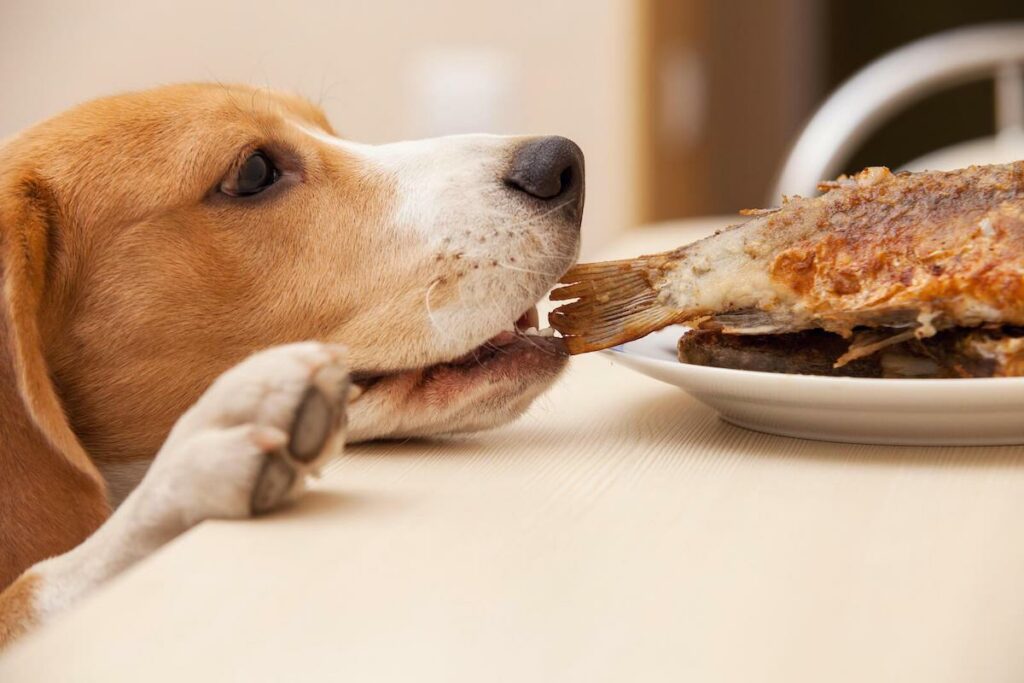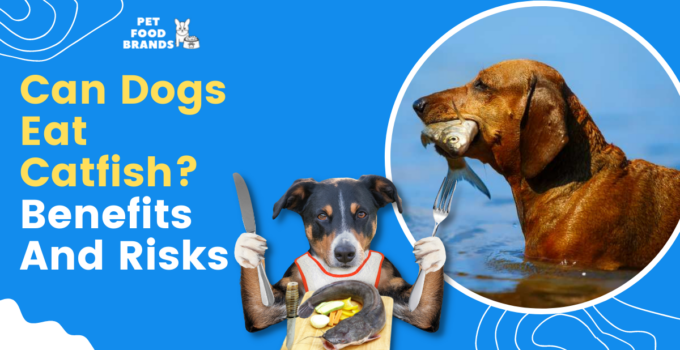Every pet parent has felt tempted to give their dog something from their plate, primarily because of the puppy eyes that are hard to say no to. But before you offer your canine family member any food, you need to ensure it is safe for them.
Although dogs are omnivorous and can eat animal matter and plants, not all animals or seafood are safe. A food that both people and dogs want to eat is catfish. But can dogs eat catfish?
Yes, dogs can eat catfish as it is safe for them. Catfishes are rich in Omega3 and fatty acids, making them a wholesome food for dogs, but the condition being you cook it well.
Please keep reading to learn how to cook catfish properly so it can be fed to dogs.
Is it Safe for Dogs to Eat Catfish?
Catfish is a highly nutritious and protein-rich food you can add to your dog’s diet. This fish is an excellent source of fatty acid Omega-3, which offers numerous health benefits to your pooch.
Remember that the fish should only be a part of your dog’s diet and not the entirety of it. Dogs need a well-balanced diet containing all the elements like fat, carbohydrates, vitamins, and minerals.
Moreover, if your dog’s trying catfish for the first time, introduce them to it in small portions. It will give you the time to ensure they don’t face any adverse reactions towards it.
Before making any changes to a dog’s diet, it is best to consult a veterinarian.
Benefits Of Giving Catfish To Dogs
Catfish can be a part of your dog’s diet owing to the many nutrients it can offer. Here are some benefits of giving catfish to dogs:
1. Improves Skin And Coat
The fatty acids in catfish can have numerous health benefits for dogs and humans. It not only supports healthy skin and coat but can also help properly develop the brain and eyes.
2. Boosts Metabolism
Aging dogs or those with weak immune systems can benefit from eating the regulated amount of catfish. This fish also contains vitamin B, which supports energy metabolism and boosts the immune system.
3. Repairs Muscles
Catfish contains many essential nutrients such as protein, fatty acids, vitamin A, vitamin D, calcium, iron, and phosphorus.
The protein present in catfish can prove beneficial for your pet dog as it not only helps build but also repair the muscles.
4. Helps Reduce Inflammation
Fatty acids Omega-3 and Omega-6 can also help with inflammation. Dogs who consume catfish can help reduce inflammation, which benefits both pets suffering from joint pain or any other inflammatory disease.
Risks Associated With Giving Dogs Catfish
Even though your dog can benefit from consuming catfish in many ways, you must be careful while incorporating it into its diet. It may lead to side effects if not given correctly or in the correct quantity.
The risk associated with dogs eating catfish are:
1. Mercury Poisoning
The longer a fish lives, the higher the mercury in it. Many fish contain a very high mercury content, which may prove dangerous for canines and lead to mercury poisoning.
Since catfish only contain a tiny amount of mercury, the chances of mercury poisoning are less. But only feed a little catfish to your dog. It might become a serious concern.
2. Bacterial Infection
Raw fish and meat always carry the risk of being hosts to parasites. These include Listeria, Salmonella, and Clostridium. They can easily enter your pup’s body and cause server health issues. They are mostly infectious, and if you have multiple dogs in your house, they can transmit from one to another.
3. Choking
Fish bones can be big choking hazards to dogs and may prove fatal. Apart from that, they may contain various harmful bacteria that lead to dog illnesses. Cooking the fish ensures that the bones are easy to swallow and bacteria-free.
Safest & Most Nutritious Way to Feed Catfish to Your Dog

Most dogs are not picky eaters, which is a pro and con at the same time. Therefore, as a dog owner, you must feed them well-cooked and nutritious food.
For now, let’s move on to some specific ways to give catfish to dogs:
1. Catfish Nuggets
Fish nuggets are both delicious and convenient to eat. And yes, you can give catfish nuggets to your dogs, provided it is in small amounts only. Breaded fish or nuggets have high calories and even salt. If your dog consumes too much of these nuggets, it can cause weight gain or even lead to an upset stomach.
2. Grilled Catfish
Like you enjoy grilled catfish, your canine companions can enjoy it since it is safe. B boneless grilled catfish can be a delicious and fun treat for your dog. However, you must ensure you don’t add anything like salt, onions, pepper, or garlic.
3. Whole Catfish
When it comes to whether consuming a whole catfish is okay or not, it depends entirely on the dog. A larger dog can easily eat a small portion of the catfish, but smaller dogs might struggle with parts like the head, tails, skin, and even bones.
4. Catfish Filets
Catfish fillets can be an excellent way to add protein to their diet, but prepare them without salt, onion, or garlic. Also, remember to remove the bones so they are safe from choking hazards.
5. Catfish Skin
Is catfish skin safe for dogs? Yes, catfish skin can be safely fed to canines only if they are adequately cooked. Freeze-dried fish skin is another great way to add them to your dog’s diet. They are light and crunch, making them a perfect dog treat.
Catfish Parts you Must Avoid Giving your Dog
Even though well-cooked catfish is safe for your dog, there are still some parts of it that you should avoid.
- Catfish Tails: It’s best to keep the tails of a catfish away from your dog as it can cause them to choke. Make sure you remove the tails from it.
- Catfish Head: Some dogs can eat the head of a catfish. The dogs love it when the catfish head is offered to them as a treat.
However, catfish heads may have harmful bacteria like Edwardsiella ictaluri, Flavobacterium column, and Aeromonas sp, leading to many health issues. Therefore, avoid adding catfish heads to your dog’s diet.
What Fish are not Safe for Dogs?
Dogs love to eat fish, and they have many benefits as well. But not all fish varieties are safe for their health. A few may be toxic and hamper their overall health are given below:
- Pufferfish: Pufferfish contains a toxic protein called tetrodotoxin that causes breathing difficulty, muscle weakness, and death in extreme cases.
- Red Tide Fish: These fishes are the ones that are exposed to red tide, a toxic algal bloom. Due to it, they contain a neurotoxin (saxitoxin) that can cause paralysis in canines.
- Blue Green Algae: Blue-green algae are often found in stagnant as well as slow-moving water. It produces toxins that cause liver damage. It can be fatal to dogs even if consumed in small amount.
- A Few Species Of Catfish: A few catfish species, like stonechat and madtom, produce a highly toxic substance – saponin, which might lead to illness if ingested by your dog.
When you cook and handle the catfish properly, the risk of toxicity reduces. But, if you feel your dog ate a toxic fish or got exposed to harmful algae, you should immediately seek veterinary care.
Frequently Asked Questions
Why Is Fried Catfish Harmful For Dogs?
It’s unsafe to give fried catfish to dogs as it may contain heavy oils, butter, and even seasonings. Fried food can upset a dog’s stomach, leading to problems like vomiting, diarrhea, or even pancreatitis.
Can I Feed Raw Catfish To Dogs?
No, it would help if you never offered raw catfish to dogs. Raw fish meat contains a variety of bacteria that can cause severe health issues.
Is Canned Catfish Safe For Dogs?
Yes, canned catfish can be a safe dog food; however, it shouldn’t contain preservatives or salt. Check the packaging label before offering it to your pup.
Can Small Puppies Eat Catfish?
Yes, but they should be adequately cooked and given in small amounts.
Can You Give Frozen Catfish To Canines?
Canines can eat frozen catfish, but you should clean it, remove bones, and cook thoroughly.
Final Thoughts
In conclusion, it is safe to feed your dog catfish. It is an excellent protein source and contains other nutrients like vitamins, minerals, calcium, phosphorus, iron, and fatty acids.
You can grill them, make nuggets or serve them as filets in every way; your dog will enjoy the yumminess of the fish and, at the same time, benefit from its nutrients. However, clean it, remove the bones, tails, and even head, and cook it evenly before giving it to your dog.
You can start by adding a small portion of catfish to your dog’s daily diet, see how they react to it, and gradually increase the intake. Seek immediate advice if you think your dog has consumed too much! Consult the veterinarian before incorporating catfish into the diet.
| Check Out These Articles |
|---|
| Can Dogs Have Ritz Crackers |
| Can Dogs Eat Raspberries |
| Can Dogs Eat Pickles |
| Can Dogs Eat Pears |
| Can Dogs Eat Onions |
| Can Dogs Eat Cherries |

Ankita is a passionate pet lover and head of content at Pet Food Brands. With her extensive knowledge and research, she provides pet owners with top-quality information on dog food and nutrition. Her dedication to improving the lives of dogs makes her a leading voice in the industry.




